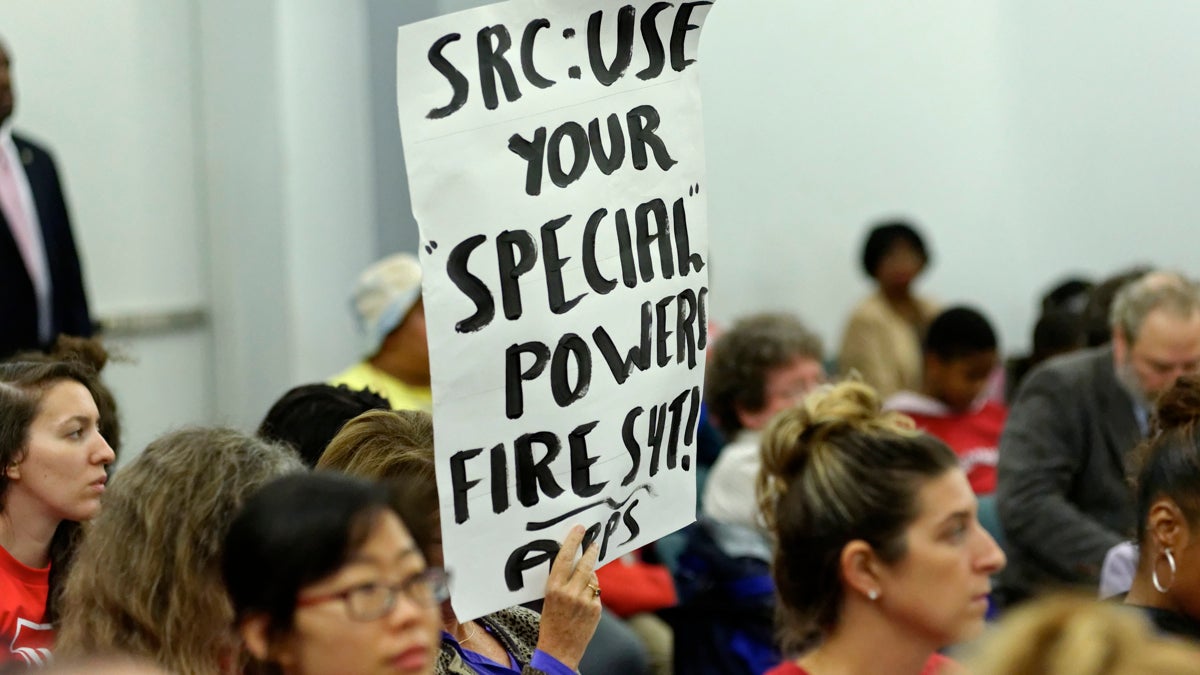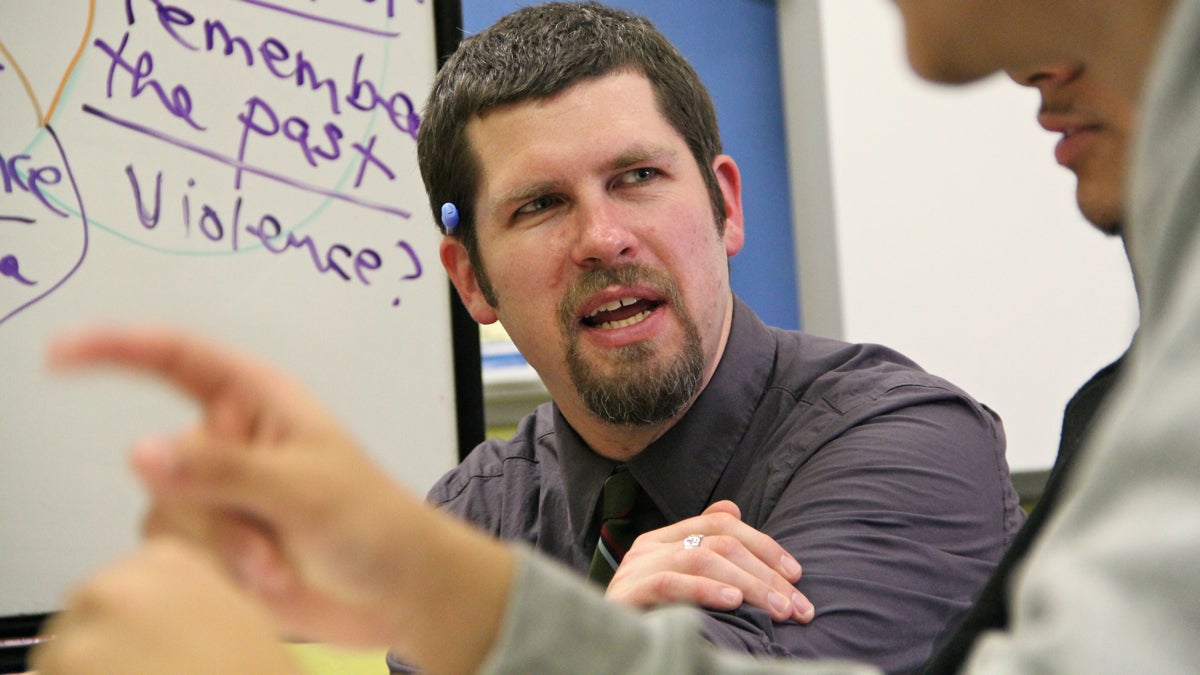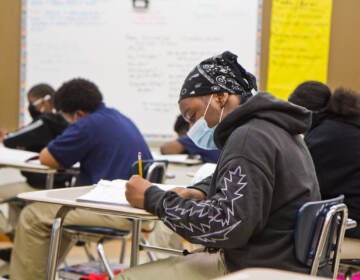School by school breakdown of Philadelphia’s substitute teacher crisis
Listen
An attendee at November's SRC meeting holds a sign urging the board to get rid of Source4Teachers. (Bastiaan Slabbers/for NewsWorks)
After outsourcing its substitute teaching services to a private firm, the School District of Philadelphia appears to have left its schools in a worse position – stressing an already fragile system plagued by deep needs.
School-by-school data obtained by Newsworks reveal that some schools have been forced to deal with staggeringly low fill-in rates.
More than 50 of the district’s 200-plus schools posted percentage fill-rates in the single digits – meaning that substitutes were only provided to teach uncovered classes less than 10 percent of the time.
In a few cases, fill rates were effectively zero. In one very troubling example, Luis Munoz-Marin elementary in Fairhill saw 244 teacher absences and only one substitute.
A slew of other schools posted similarly distressing rates, calling into question the wisdom of the district’s decision to outsource the service.
You can see the fill-in rates for all district schools in the interactive graph below.
Source4Teachers – a Cherry Hill, NJ-based firm that lacked experience staffing a large, urban district – was awarded a $34 million contract in June 2015.
In 2014-15, the year before the district engaged Source4Teachers, when teachers called out, the spots were filled by substitutes 64 percent of the time.
This year, Source4Teachers pledged to deliver a 75 percent fill-rate on the first day of school, and a 90 percent rate by January 1.
The firm fell well short of those promises. Rates were in the teens system-wide in the first weeks of classes. In the days before Christmas, it peaked at 37 percent.
When substitutes don’t show, teachers at the affected school scramble to fill in.
“It just becomes really difficult for the kids more than anybody,” said Sydney Coffin, an English teacher at Edison High School. “Teachers get stressed, yeah, definitely, but the kids get stressed too because they don’t know who they can rely on.”
The school-by-school breakdown below is based on district data that Newsworks obtained through a Right-to-Know request seeking fill-rates from the first day of school through Winter break.
iframe html body #middle #overlay div#owerlay {
margin: 0;
}
The data show that schools with higher student poverty levels have a harder time getting substitutes.
Only four schools in the top 20 for percentage fill rate have an economically disadvantaged population that exceeds the district average, which is 87 percent. Those are The U School, Overbrook High School, Murrell Dobbins High School, and Widener Memorial School.
The district had hoped that Source4Teachers would find better ways to attract substitutes to its most impoverished schools – which has long been a problem.
Instead, through at least the first four months of school, that promise remains unfulfilled.
At James G. Blaine elementary in Strawberry Mansion, one of the district’s “internal turnaround” schools, Source4Teachers filled six substitute positions for 363 teacher absences.
Similarly, the firm filled six substitutes for the 325 teacher absences at Avery D. Harrington elementary in West Philadelphia.
Many district principals did not return calls for comment for this story. Some wished only to speak on background, confirming that this year has been especially challenging because of the lack of substitutes.
Others, including Blaine principal Gianeen Powell, said Source4Teachers performance didn’t seem particularly out of step with prior years.
“For me, at Blaine, I don’t think substitutes have ever come here,” said Powell, who’s in her 8th year at the helm. “We already know that we have to pull a prep teacher, we have to do coverages. That’s just a natural, normal thing that I’ve always been doing.”
22kmsubs2Create your own infographics
The daily substitute problem has been severely compounded by the 168 openings and long-term vacancies that remain unfilled in district schools.
In the first five months of the school year, Source4Teachers was responsible for filling long term vacancies. As of late January, the district took that responsibility back, but officials say it’s proved very challenging to attract qualified candidates.
All these staffing difficulties have wreaked havoc in many schools – causing educators to sacrifice daily preparation time and sometimes teach courses beyond the scope of their state certifications.
Newsworks requested a breakdown of how long-term vacancy numbers have fluctuated at each school over the course of the first four months, but the district denied the request, stating that it does not keep a historical record.
The list of current vacancies can be viewed here.
At Edison High School in North Philadelphia, where Coffin teaches, the problem has been especially severe. Of 726 daily teacher absences from September-December, Source4Teachers filled 74 slots – a 10 percent fill rate.
 Thomas Edison High School teacher Sydney Coffin says the substitute teacher crisis has added to the already overwhelming challenges the Philadelphia schools face. (Emma Lee/WHYY)
Thomas Edison High School teacher Sydney Coffin says the substitute teacher crisis has added to the already overwhelming challenges the Philadelphia schools face. (Emma Lee/WHYY)
Edison has had up to ten unfilled long-term vacancies at the same time this year. According to the district’s count, there are currently six.
“It was really bumpy in the beginning, where there just wasn’t anybody coming,” said Coffin.
To Coffin, Source4Teachers’ disappointing performance is more than a headline; it’s something that has had real, tangible effects on student learning and school climate.
Coffin says ninth graders have been particularly affected.
“There was one class that I covered in the beginning of the year – maybe six, seven times – they just have never had a teacher,” he said.
For Freshman making the transition from high school, that lack of stability and clear authority is especially disorienting. The problem was made worse at Edison through the first few months of classes because the school then lacked non-teaching assistants to patrol the hallways.
“When they don’t know what their place is they tend to wander,” said Coffin of ninth graders. “And in our building…they were wandering all over the building and causing mayhem.”
District officials have expressed displeasure with Source4Teachers performance, but Superintendent William Hite has decided against cancelling the contract and reverting to the old method – which employed substitutes at higher pay with union protections.
“We are not where we should be We are very dissatisfied, and unfortunately that means a lot of our teachers, a lot of our schools, and most importantly our students are not being serviced,” said district spokesman Fernando Gallard, “but we are seeing some improvement.”
Source4Teachers’ fill rates have gotten better, but they still fall well short of contracted promises.
This week, the overall fill-rate reached 56 percent, the highest level of the school year, after hovering around 45 percent for much of February. Source4Teachers has said it needs 5,000 substitute teachers in its pool to be able to serve the district effectively. Currently, the firm has only 590. Last year, the district had 1,200 subs in its pool.
The district has levied financial penalties for underperformance, and the private firm – not the district – must also pay teachers extra for covering vacancies during their prep periods.
Lasting effects?
But even if the rate improves, educators say much of the damage done this year will not be easily repaired.
At Blaine, Principal Powell says long-term vacancies have seriously disrupted the second year of their turnaround work. Teachers have had to cover both long-term and daily vacancies so often that their ability to collaborate and reflect on improving pedagogy has been stunted.
But she understands the difficulty of finding full-time teachers who are willing to devote themselves to a school with extraordinary needs.
“We’re not looking for just anybody,” she said. “We’re looking for the right person.”
At Edison, Coffin carries the weight of knowing that the ability to make meaningful connections with students in times of austerity budgets, bare-bones staffing, and high class sizes is an uphill battle.
The persistence of long-term vacancies and the lack of daily substitutes are just two more stressors on a long, overwhelming list.
A few of Coffin’s classes this year have more than 33 students – the contracted maximum. Last year, he taught a junior level English class with 51 students.
“Kids slip through the cracks,” said Coffin, growing emotional. “I lost two of those juniors over the summer to homicide. And that is not lost on me, that as much as you do for all these kids, you’re going to lose some. Those are not the kids I expected to lose, but I know I’m losing kids everyday because there are just too many of them.”
Coffin, who runs Edison’s poetry team, was particularly close with one of the victims – a budding poet named Tyrone Tillman who was slain in a hit-and-run in July.
“We have such complicated relationships with students. We’re not their parents, but here’s a kid who used to call me ‘Dad.’ He’d joke around, you know,” said Coffin, fighting back tears. “But we get attached to our students. And he’s one.”
Dealing with that loss has only made Coffin reflect more deeply on all the students who he feels the system is letting down.
But despite the underperforming Source4Teachers contract, the lack of enough guidance counselors, and all of the immense challenges, Coffin remains wearily determined.
“It’s the greatest job on earth. What did Kennedy say about the Peace Corps? ‘It’s the toughest job you’ll ever love.’ This is the closest thing to the Peace Corps. It’s in America. It’s right here,” he said. “It’s where I live.”
WHYY is your source for fact-based, in-depth journalism and information. As a nonprofit organization, we rely on financial support from readers like you. Please give today.





